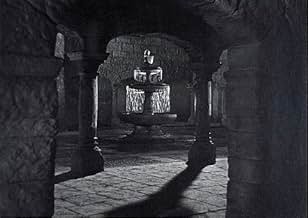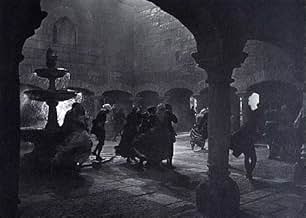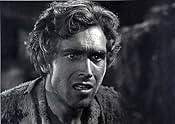Ajouter une intrigue dans votre langueSet in the early part of 20th century Europe, where a dancer becomes the romantic bone of contention between 2 men; a humble shepherd and an imperious marquis.Set in the early part of 20th century Europe, where a dancer becomes the romantic bone of contention between 2 men; a humble shepherd and an imperious marquis.Set in the early part of 20th century Europe, where a dancer becomes the romantic bone of contention between 2 men; a humble shepherd and an imperious marquis.
Frida Richard
- Josefa, eine alte Magd
- (as Frieda Richard)
Max Holzboer
- Der Müller Natario
- (as Max Holsboer)
Till Klockow
- Voice of Donna Amelia
- (voix)
- (non crédité)
Histoire
Le saviez-vous
- AnecdotesLeni Riefenstahl claimed throughout her life that all the gypsies used in the film as extras were treated very well and that "all of them were seen after the war", safe and sound. It was not until the late 70's and 80's that documents were found proving that she personally went and selected the gypsy extras in the Maxglan-Leopoldskron camp (near Salzburg) for filming in the Dolomites in 1940, and in 1942, in the Marzahn camp for the studio scenes, filmed in Babelsberg. These extras are seen, for instance, in the dancing sequence in the tavern, and when gypsy children run along Pedro when he comes down from the mountain to marry Martha. It is also now proven that most of the Gypsy extras perished in the Auschwitz extermination camp.
- Versions alternativesThis film was published in Italy in an DVD anthology entitled "La bella maledetta", distributed by DNA Srl. The film has been re-edited with the contribution of the film history scholar Riccardo Cusin . This version is also available in streaming on some platforms.
- ConnexionsEdited into Leni Riefenstahl - Le Pouvoir des images (1993)
Commentaire à la une
The troubles that beset this final feature of Leni Riefenstahl, from its conception in 1934 to its eventual release twenty years later have been well-documented and one critic has suggested that reading about it is far more interesting that watching it. The film's reputation has been overshadowed of course by the knowledge that the Romany gypsies she cast as extras were destined to perish in Auschwitz. Despite her lifelong assertions that she knew nothing of their fate the stigma remained, which is hardly surprising as she was renowned for her 'selective' memory and for being economic with the actualité.
Thanks to her documentaries 'Triumph of the Will' and 'Olympia' she is the director with the highest profile of her contemporaries and consequently the biggest target. In fact the average film-goer would probably struggle to name any other German director of the same period.
'Tiefland' was shown out of competition at Cannes in 1954 and the critical response was mainly negative, especially in relation to her being too old to play Martha the Spanish dancer who fills with fire the veins of Don Sebastian and captivates the heart of a considerably younger Pedro the shepherd. Riefenstahl herself admitted that she was miscast but claimed that she could find no actress suitable for the role. Franz Eichberger as Pedro is rather one-dimensional but then most 'goodies' are. 'The baddies' are invariably more interesting and Bernhard Minetti is wonderfully wicked as Don Sebastian. By far the most interesting performance is that Maria Koppenhoefer as Dona Amelia. An absolutely fascinating artiste who was fated to die six years before the film came out.
Even her staunchest critic could not deny the visual magnificence of this piece. After all Riefenstahl had learnt her craft from Arnold Fanck and G. W. Pabst. By all accounts both of these as well as Veit Harlan 'assisted' with the direction. Just what this assistance amounted to over the film's protracted shooting schedule is impossible to determine. As well as her sense of the visual and of composition and lighting, evident here is Riefenstahl's mastery of editing which was second to none. The piece is aided immeasurably by the score of her preferred composer Herbert Windt and in its use of themes from Eugen d'Albert's original opera. Whatever its weaknesses the film remains both intriguing and mesmerising.
Although Time is a great healer it is unlikely that the controversy surrounding this director will ever go away. Indeed why should it? She may not have been a jackpot of admirable character traits but as her obituaries in 2003 pointed out, her position as a great film technician is beyond dispute.
Thanks to her documentaries 'Triumph of the Will' and 'Olympia' she is the director with the highest profile of her contemporaries and consequently the biggest target. In fact the average film-goer would probably struggle to name any other German director of the same period.
'Tiefland' was shown out of competition at Cannes in 1954 and the critical response was mainly negative, especially in relation to her being too old to play Martha the Spanish dancer who fills with fire the veins of Don Sebastian and captivates the heart of a considerably younger Pedro the shepherd. Riefenstahl herself admitted that she was miscast but claimed that she could find no actress suitable for the role. Franz Eichberger as Pedro is rather one-dimensional but then most 'goodies' are. 'The baddies' are invariably more interesting and Bernhard Minetti is wonderfully wicked as Don Sebastian. By far the most interesting performance is that Maria Koppenhoefer as Dona Amelia. An absolutely fascinating artiste who was fated to die six years before the film came out.
Even her staunchest critic could not deny the visual magnificence of this piece. After all Riefenstahl had learnt her craft from Arnold Fanck and G. W. Pabst. By all accounts both of these as well as Veit Harlan 'assisted' with the direction. Just what this assistance amounted to over the film's protracted shooting schedule is impossible to determine. As well as her sense of the visual and of composition and lighting, evident here is Riefenstahl's mastery of editing which was second to none. The piece is aided immeasurably by the score of her preferred composer Herbert Windt and in its use of themes from Eugen d'Albert's original opera. Whatever its weaknesses the film remains both intriguing and mesmerising.
Although Time is a great healer it is unlikely that the controversy surrounding this director will ever go away. Indeed why should it? She may not have been a jackpot of admirable character traits but as her obituaries in 2003 pointed out, her position as a great film technician is beyond dispute.
- brogmiller
- 22 juil. 2021
- Permalien
Meilleurs choix
Connectez-vous pour évaluer et suivre la liste de favoris afin de recevoir des recommandations personnalisées
- How long is Lowlands?Alimenté par Alexa
Détails
- Durée1 heure 39 minutes
- Couleur
- Mixage
- Rapport de forme
- 1.37 : 1
Contribuer à cette page
Suggérer une modification ou ajouter du contenu manquant























